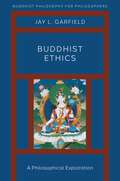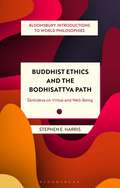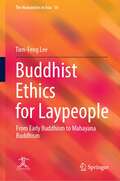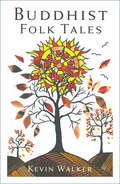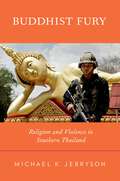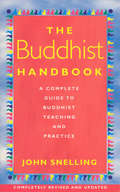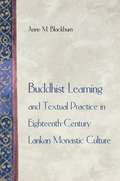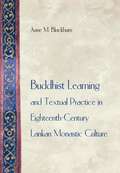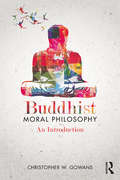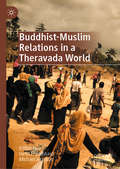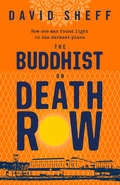- Table View
- List View
Buddhist Economics: An Enlightened Approach to the Dismal Science
by Clair BrownIn the tradition of E. F. Schumacher's Small Is Beautiful, renowned economist Clair Brown argues persuasively for a new economics built upon equality, sustainability, and right living."Buddhist Economics will give guidance to all those who seek peace, fairness, and environmental sustainability." -Jeffrey Sachs, author of The Age of Sustainable Development.Traditional economics measures the ways in which we spend our income, but doesn't attribute worth to the crucial human interactions that give our lives meaning. Clair Brown, an economics professor at U.C. Berkeley and a practicing Buddhist, has developed a holistic model, one based on the notion that quality of life should be measured by more than national income. Brown advocates an approach to organizing the economy that embraces rather than skirts questions of values, sustainability, and equity. Complementing the award-winning work of Jeffrey Sachs and Bill McKibben, and the paradigm-breaking spirit of Amartya Sen, Robert Reich, and Thomas Piketty, Brown incorporates the Buddhist emphasis on interdependence, shared prosperity, and happiness into her vision for a sustainable and compassionate world. Buddhist economics leads us to think mindfully as we go about our daily activities, and offers a way to appreciate how our actions affect the well-being of those around us. By replacing the endless cycle of desire with more positive collective activities, we can make our lives more meaningful as well as happier. Inspired by the popular course Professor Brown teaches at U.C. Berkeley, Buddhist Economics represents an enlightened approach to our modern world infused with ancient wisdom, with benefits both personal and global, for generations to come.
Buddhist Ethics: A Philosophical Exploration (Buddhist Philosophy for Philosophers)
by Jay L. GarfieldBuddhist Ethics presents an outline of Buddhist ethical thought. It is not a defense of Buddhist approaches to ethics as opposed to any other, nor is it a critique of the Western tradition. Garfield presents a broad overview of a range of Buddhist approaches to the question of moral philosophy. He draws on a variety of thinkers, reflecting the great diversity of this 2500-year-old tradition in philosophy but also the principles that tie them together. In particular, he engages with the literature that argues that Buddhist ethics is best understood as a species of virtue ethics, and with those who argue that it is best understood as consequentialist. Garfield argues that while there are important points of contact with these Western frameworks, Buddhist ethics is distinctive, and is a kind of moral phenomenology that is concerned with the ways in which we experience ourselves as agents and others as moral fellows. With this framework, Garfield explores the connections between Buddhist ethics and recent work in moral particularism, such as that of Jonathan Dancy, as well as the British and Scottish sentimentalist tradition represented by Hume and Smith.
Buddhist Ethics: A Philosophical Exploration (Buddhist Philosophy for Philosophers)
by Jay L. GarfieldBuddhist Ethics presents an outline of Buddhist ethical thought. It is not a defense of Buddhist approaches to ethics as opposed to any other, nor is it a critique of the Western tradition. Garfield presents a broad overview of a range of Buddhist approaches to the question of moral philosophy. He draws on a variety of thinkers, reflecting the great diversity of this 2500-year-old tradition in philosophy but also the principles that tie them together. In particular, he engages with the literature that argues that Buddhist ethics is best understood as a species of virtue ethics, and with those who argue that it is best understood as consequentialist. Garfield argues that while there are important points of contact with these Western frameworks, Buddhist ethics is distinctive, and is a kind of moral phenomenology that is concerned with the ways in which we experience ourselves as agents and others as moral fellows. With this framework, Garfield explores the connections between Buddhist ethics and recent work in moral particularism, such as that of Jonathan Dancy, as well as the British and Scottish sentimentalist tradition represented by Hume and Smith.
Buddhist Ethics and the Bodhisattva Path: Santideva on Virtue and Well-Being (Bloomsbury Introductions to World Philosophies)
by Stephen HarrisSantideva's 8th century Mahayana Buddhist classic, the Guide to the Practices of Awakening (Bodhicaryavatara), has been a source of philosophical inspiration in the Indian and Tibetan traditions for over a thousand years. Stephen Harris guides us through a philosophical exploration of Santideva's masterpiece, introducing us to his understanding of the compassionate bodhisattva, who vows to liberate the entire universe from suffering. Individual chapters provide studies of the bodhisattva virtues of generosity, patience, compassion, and wisdom, illustrating the role each plays in Santideva's account of well-being and moral development. Harris also provides in-depth analysis of many of Santideva's most influential arguments, demonstrating how he employs reasoning as a method to cultivate moral character. As the first book-length English language philosophical study of Santideva's most influential text, this will be essential reading for students and scholars of Buddhist ethics, as well as for anyone interested in intercultural ethics and the philosophy of well-being.
Buddhist Ethics and the Bodhisattva Path: Santideva on Virtue and Well-Being (Bloomsbury Introductions to World Philosophies)
by Stephen HarrisSantideva's 8th century Mahayana Buddhist classic, the Guide to the Practices of Awakening (Bodhicaryavatara), has been a source of philosophical inspiration in the Indian and Tibetan traditions for over a thousand years. Stephen Harris guides us through a philosophical exploration of Santideva's masterpiece, introducing us to his understanding of the compassionate bodhisattva, who vows to liberate the entire universe from suffering. Individual chapters provide studies of the bodhisattva virtues of generosity, patience, compassion, and wisdom, illustrating the role each plays in Santideva's account of well-being and moral development. Harris also provides in-depth analysis of many of Santideva's most influential arguments, demonstrating how he employs reasoning as a method to cultivate moral character. As the first book-length English language philosophical study of Santideva's most influential text, this will be essential reading for students and scholars of Buddhist ethics, as well as for anyone interested in intercultural ethics and the philosophy of well-being.
Buddhist Ethics for Laypeople: From Early Buddhism to Mahayana Buddhism (The Humanities in Asia #10)
by Tien-Feng LeeThis book comprehensively discusses the topics in Buddhism that are crucial for promoting lay people’s welfare—from mundane bliss in this life, i.e., wealth and good interpersonal relationships, to prosperity in the future, i.e., a good rebirth and less time spent in Samsara. This book presents some moral guidelines and a spiritual training path designed for householders and lay Buddhists, helping them secure the welfare. The guidelines and the training path presented in the book are based on the Pali Nikāyas and the Chinese Āgamas in Early Buddhism and an influential Chinese Mahayana scripture—the Upāsakaśīla Sūtra
Buddhist Ethics: A Very Short Introduction (Very Short Introductions)
by Damien KeownWith over 520 million followers, Buddhism is now the world's fourth largest religion. Over the last seventy years or so there has been a growing interest in Buddhism, and it continues to capture the imagination of many in the West, who see it as either an alternative or a supplement to their own religious beliefs. For complex cultural and historical reasons, ethics has not received as much attention in traditional Buddhist thought as it has in the West. In this Very Short Introduction, Damien Keown explores how Buddhism approaches a range of moral issues of our age, including our relationship with our environment, our treatment of animals, and our stance on abortion, on sexuality and gender, on violence and war. This new edition also includes a discussion of the ethical challenges posed by cutting-edge developments in science and biomedical technologies, including neuroscience, artificial intelligence, transhumanism, and gene editing. ABOUT THE SERIES: The Very Short Introductions series from Oxford University Press contains hundreds of titles in almost every subject area. These pocket-sized books are the perfect way to get ahead in a new subject quickly. Our expert authors combine facts, analysis, perspective, new ideas, and enthusiasm to make interesting and challenging topics highly readable.
Buddhist Ethics: A Very Short Introduction (Very Short Introductions)
by Damien KeownWith over 520 million followers, Buddhism is now the world's fourth largest religion. Over the last seventy years or so there has been a growing interest in Buddhism, and it continues to capture the imagination of many in the West, who see it as either an alternative or a supplement to their own religious beliefs. For complex cultural and historical reasons, ethics has not received as much attention in traditional Buddhist thought as it has in the West. In this Very Short Introduction, Damien Keown explores how Buddhism approaches a range of moral issues of our age, including our relationship with our environment, our treatment of animals, and our stance on abortion, on sexuality and gender, on violence and war. This new edition also includes a discussion of the ethical challenges posed by cutting-edge developments in science and biomedical technologies, including neuroscience, artificial intelligence, transhumanism, and gene editing. ABOUT THE SERIES: The Very Short Introductions series from Oxford University Press contains hundreds of titles in almost every subject area. These pocket-sized books are the perfect way to get ahead in a new subject quickly. Our expert authors combine facts, analysis, perspective, new ideas, and enthusiasm to make interesting and challenging topics highly readable.
Buddhist Extremists and Muslim Minorities: Religious Conflict in Contemporary Sri Lanka
When the civil war in Sri Lanka between Sinhala Buddhists and Tamils ended in 2009, many Sri Lankans and foreign observers alike hoped to see the re-establishment of relatively harmonious religious and ethnic relations among the various communities in the country. Instead, a different type of violence erupted, this time aimed at the Muslim community. The essays in Buddhist Extremists and Muslim Minorities investigate the history and current state of Buddhist-Muslim relations in Sri Lanka, in an attempt to identify the causes of this newly emergent conflict. Euro-American readers unfamiliar with this story will be surprised to learn that it inverts common stereotypes of the two religious groups. In this context, certain groups of Buddhists, generally considered peace-oriented in the West, are engaged in victimizing Muslims, who are increasingly seen as militant. The authors examine the historical contexts and substantive reasons that gave rise to Buddhist nationalism and aggressive attacks on Muslim communities. The rise of Buddhist nationalism in general is analyzed and explained, while the specific role, methods, and character of the militant Bodu Bala Sena ("Army of Buddhist Power") movement receive particular scrutiny. The motivations for attacks on Muslims may include deep-seated perceptions of economic disparity, but elements of religious culture (ritual and symbol) are also seen as catalysts for explosive acts of violence. This much-needed, timely commentary promises to shift the standard narrative on Muslims and religious violence.
Buddhist Feminism: Transforming Anger against Patriarchy (Palgrave Studies in Comparative East-West Philosophy)
by Sokthan YengWhat is Buddhist Feminism? This book examines reasons why Buddhism and feminism may seem to be incompatible, and shows that Buddhist and feminist philosophies can work together to challenge patriarchal structures. Current scholarship usually compares Buddhism and feminism to judge their compatibility, rather than describing a Buddhist Feminist perspective or method. Sokthan Yeng instead looks for a pattern that connects Buddhist and feminist traditions. In particular, she explores possible exchanges between feminist and Buddhist philosophies which highlight how they each contribute to a more nuanced understanding of anger. Yeng explores how a Buddhist feminist approach would allow women’s anger to be transformed from that which is outside the bounds of philosophy into that which contributes to philosophical discourse in the East and West, and between the two.
Buddhist Folk Tales: Early Bronze Age Settlement (Supplementary Volume Ser.)
by Kevin WalkerBuddhist Folk Tales is a wonderful collection of ancient and modern stories from the Buddhist tradition. From short, snappy tales to longer narratives, they will entertain and tantalise the emotions. Laugh, sigh and cry at stories about previous lives, why the Monkey King wanted to be Master of the Universe, the grimace that comes with the phrase ‘out of the mouths of babes’, and ever-endearing mother love. This is a book to treasure, and read time and again.
Buddhist Fury: Religion and Violence in Southern Thailand
by Michael K. JerrysonBuddhist violence is not a well-known concept. In fact, it is generally considered an oxymoron. An image of a Buddhist monk holding a handgun or the idea of a militarized Buddhist monastery tends to stretch the imagination; yet these sights exist throughout southern Thailand. Michael Jerryson offers an extensive examination of one of the least known but longest-running conflicts of Southeast Asia. Part of this conflict, based primarily in Thailand's southernmost provinces, is fueled by religious divisions. Thailand's total population is over 92 percent Buddhist, but over 85 percent of the people in the southernmost provinces are Muslim. Since 2004, the Thai government has imposed martial law over the territory and combatted a grass-roots militant Malay Muslim insurgency. Buddhist Fury reveals the Buddhist parameters of the conflict within a global context. Through fieldwork in the conflict area, Jerryson chronicles the habits of Buddhist monks in the militarized zone. Many Buddhist practices remain unchanged. Buddhist monks continue to chant, counsel the laity, and accrue merit. Yet at the same time, monks zealously advocate Buddhist nationalism, act as covert military officers, and equip themselves with guns. Buddhist Fury displays the methods by which religion alters the nature of the conflict and shows the dangers of this transformation.
Buddhist Fury: Religion and Violence in Southern Thailand
by Michael K. JerrysonBuddhist violence is not a well-known concept. In fact, it is generally considered an oxymoron. An image of a Buddhist monk holding a handgun or the idea of a militarized Buddhist monastery tends to stretch the imagination; yet these sights exist throughout southern Thailand. Michael Jerryson offers an extensive examination of one of the least known but longest-running conflicts of Southeast Asia. Part of this conflict, based primarily in Thailand's southernmost provinces, is fueled by religious divisions. Thailand's total population is over 92 percent Buddhist, but over 85 percent of the people in the southernmost provinces are Muslim. Since 2004, the Thai government has imposed martial law over the territory and combatted a grass-roots militant Malay Muslim insurgency. Buddhist Fury reveals the Buddhist parameters of the conflict within a global context. Through fieldwork in the conflict area, Jerryson chronicles the habits of Buddhist monks in the militarized zone. Many Buddhist practices remain unchanged. Buddhist monks continue to chant, counsel the laity, and accrue merit. Yet at the same time, monks zealously advocate Buddhist nationalism, act as covert military officers, and equip themselves with guns. Buddhist Fury displays the methods by which religion alters the nature of the conflict and shows the dangers of this transformation.
Buddhist Goddesses of India: Essays in Economic History and Development (PDF)
by Miranda ShawThe Indian Buddhist world abounds with goddesses—graceful nature divinities, maternal nurturers, potent healers, mighty protectors, transcendent wisdom figures, cosmic mothers of liberation, and dancing female Buddhas. Despite their importance in Buddhist thought and practice, female deities have received relatively little scholarly attention, and no comprehensive study of the female pantheon has been available.Buddhist Goddesses of India chronicles the histories, legends, and artistic portrayals of nineteen goddesses and several related human figures and texts. Beautifully illustrated and drawing on a sweeping range of material, from devotional poetry and meditation manuals to rituals and artistic images, Shaw reveals the character, powers, and practice traditions of the female divinities in this definitive and essential guide.
The Buddhist Handbook: A Complete Guide to Buddhist Teaching and Practice
by John SnellingBuddhism is one of the fastest growing religions in the world today -and THE BUDDHIST HANDBOOK is the best introduction to the teachings of Buddhism, the main schools, the Buddhist world-view, leading Buddhist teachers, Buddhist festivals and meditation. 'There is a great need to come to terms with Buddhism AS A WHOLE. John Snelling's book is an admirable attempt to do just that. ' GOLDEN DRUM 'A clear, up-to-date survey. ' CATHOLIC HERALD
Buddhist Inclusivism: Attitudes Towards Religious Others (Ashgate World Philosophies Series)
by Kristin Beise KiblingerAlthough Christians have well-developed responses to other religions, the counterpart scholarship from Buddhists has thus far lagged behind. Breaking new ground, Buddhist Inclusivism analyzes the currently favored position towards religious others, inclusivism, in Buddhist traditions. Kristin Beise Kiblinger presents examples of inclusivism from a wide range of Buddhist contexts and periods, from Pali texts to the Dalai Lama's recent works. After constructing and defending a preferred, alternative form of Buddhist inclusivism, she evaluates the thought of particular contemporary Buddhists such as Thich Nhat Hanh and Masao Abe in light of her ideal position. This book offers a more systematic treatment of Buddhist inclusivism than has yet been provided either by scholars or by Buddhist leaders.
Buddhist Inclusivism: Attitudes Towards Religious Others (Ashgate World Philosophies Series)
by Kristin Beise KiblingerAlthough Christians have well-developed responses to other religions, the counterpart scholarship from Buddhists has thus far lagged behind. Breaking new ground, Buddhist Inclusivism analyzes the currently favored position towards religious others, inclusivism, in Buddhist traditions. Kristin Beise Kiblinger presents examples of inclusivism from a wide range of Buddhist contexts and periods, from Pali texts to the Dalai Lama's recent works. After constructing and defending a preferred, alternative form of Buddhist inclusivism, she evaluates the thought of particular contemporary Buddhists such as Thich Nhat Hanh and Masao Abe in light of her ideal position. This book offers a more systematic treatment of Buddhist inclusivism than has yet been provided either by scholars or by Buddhist leaders.
Buddhist Learning and Textual Practice in Eighteenth-Century Lankan Monastic Culture (Buddhisms: A Princeton University Press Series #12)
by Anne M. BlackburnAnne Blackburn explores the emergence of a predominant Buddhist monastic culture in eighteenth-century Sri Lanka, while asking larger questions about the place of monasticism and education in the creation of religious and national traditions. Her historical analysis of the Siyam Nikaya, a monastic order responsible for innovations in Buddhist learning, challenges the conventional view that a stable and monolithic Buddhism existed in South and Southeast Asia prior to the advent of British colonialism in the nineteenth century. The rise of the Siyam Nikaya and the social reorganization that accompanied it offer important evidence of dynamic local traditions. Blackburn supports this view with fresh readings of Buddhist texts and their links to social life beyond the monastery. Comparing eighteenth-century Sri Lankan Buddhist monastic education to medieval Christian and other contexts, the author examines such issues as bilingual commentarial practice, the relationship between clerical and "popular" religious cultures, the place of preaching in the constitution of "textual communities," and the importance of public displays of learning to social prestige. Blackburn draws upon indigenous historical narratives, which she reads as rhetorical texts important to monastic politics and to the naturalization of particular attitudes toward kingship and monasticism. Moreover, she questions both conventional views on "traditional" Theravadin Buddhism and the "Buddhist modernism" / "Protestant Buddhism" said to characterize nineteenth-century Sri Lanka. This book provides not only a pioneering critique of post-Orientalist scholarship on South Asia, but also a resolution to the historiographic impasse created by post-Orientalist readings of South Asian history.
Buddhist Learning and Textual Practice in Eighteenth-Century Lankan Monastic Culture (PDF)
by Anne M. BlackburnAnne Blackburn explores the emergence of a predominant Buddhist monastic culture in eighteenth-century Sri Lanka, while asking larger questions about the place of monasticism and education in the creation of religious and national traditions. Her historical analysis of the Siyam Nikaya, a monastic order responsible for innovations in Buddhist learning, challenges the conventional view that a stable and monolithic Buddhism existed in South and Southeast Asia prior to the advent of British colonialism in the nineteenth century. The rise of the Siyam Nikaya and the social reorganization that accompanied it offer important evidence of dynamic local traditions. Blackburn supports this view with fresh readings of Buddhist texts and their links to social life beyond the monastery. Comparing eighteenth-century Sri Lankan Buddhist monastic education to medieval Christian and other contexts, the author examines such issues as bilingual commentarial practice, the relationship between clerical and "popular" religious cultures, the place of preaching in the constitution of "textual communities," and the importance of public displays of learning to social prestige. Blackburn draws upon indigenous historical narratives, which she reads as rhetorical texts important to monastic politics and to the naturalization of particular attitudes toward kingship and monasticism. Moreover, she questions both conventional views on "traditional" Theravadin Buddhism and the "Buddhist modernism" / "Protestant Buddhism" said to characterize nineteenth-century Sri Lanka. This book provides not only a pioneering critique of post-Orientalist scholarship on South Asia, but also a resolution to the historiographic impasse created by post-Orientalist readings of South Asian history.
Buddhist Modernities: Re-inventing Tradition in the Globalizing Modern World (Routledge Studies in Religion)
by Hanna Havnevik Ute Hüsken Mark Teeuwen Vladimir Tikhonov Koen WellensThe transformations Buddhism has been undergoing in the modern age have inspired much research over the last decade. The main focus of attention has been the phenomenon known as Buddhist modernism, which is defined as a conscious attempt to adjust Buddhist teachings and practices in conformity with the modern norms of rationality, science, or gender equality. This book advances research on Buddhist modernism by attempting to clarify the highly diverse ways in which Buddhist faith, thought, and practice have developed in the modern age, both in Buddhist heartlands in Asia and in the West. It presents a collection of case studies that, taken together, demonstrate how Buddhist traditions interact with modern phenomena such as colonialism and militarism, the market economy, global interconnectedness, the institutionalization of gender equality, and recent historical events such as de-industrialization and the socio-cultural crisis in post-Soviet Buddhist areas. This volume shows how the (re)invention of traditions constitutes an important pathway in the development of Buddhist modernities and emphasizes the pluralistic diversity of these forms in different settings.
Buddhist Modernities: Re-inventing Tradition in the Globalizing Modern World (Routledge Studies in Religion)
by Hanna Havnevik Ute Hüsken Mark Teeuwen Vladimir Tikhonov Koen WellensThe transformations Buddhism has been undergoing in the modern age have inspired much research over the last decade. The main focus of attention has been the phenomenon known as Buddhist modernism, which is defined as a conscious attempt to adjust Buddhist teachings and practices in conformity with the modern norms of rationality, science, or gender equality. This book advances research on Buddhist modernism by attempting to clarify the highly diverse ways in which Buddhist faith, thought, and practice have developed in the modern age, both in Buddhist heartlands in Asia and in the West. It presents a collection of case studies that, taken together, demonstrate how Buddhist traditions interact with modern phenomena such as colonialism and militarism, the market economy, global interconnectedness, the institutionalization of gender equality, and recent historical events such as de-industrialization and the socio-cultural crisis in post-Soviet Buddhist areas. This volume shows how the (re)invention of traditions constitutes an important pathway in the development of Buddhist modernities and emphasizes the pluralistic diversity of these forms in different settings.
Buddhist Moral Philosophy: An Introduction
by Christopher W. GowansThe first book of its kind, Buddhist Moral Philosophy: An Introduction introduces the reader to contemporary philosophical interpretations and analyses of Buddhist ethics. It begins with a survey of traditional Buddhist ethical thought and practice, mainly in the Pali Canon and early Mah?y?na schools, and an account of the emergence of Buddhist moral philosophy as a distinct discipline in the modern world. It then examines recent debates about karma, rebirth and nirvana, well-being, normative ethics, moral objectivity, moral psychology, and the issue of freedom, responsibility and determinism. The book also introduces the reader to philosophical discussions of topics in socially engaged Buddhism such as human rights, war and peace, and environmental ethics.
Buddhist Moral Philosophy: An Introduction
by Christopher W. GowansThe first book of its kind, Buddhist Moral Philosophy: An Introduction introduces the reader to contemporary philosophical interpretations and analyses of Buddhist ethics. It begins with a survey of traditional Buddhist ethical thought and practice, mainly in the Pali Canon and early Mah?y?na schools, and an account of the emergence of Buddhist moral philosophy as a distinct discipline in the modern world. It then examines recent debates about karma, rebirth and nirvana, well-being, normative ethics, moral objectivity, moral psychology, and the issue of freedom, responsibility and determinism. The book also introduces the reader to philosophical discussions of topics in socially engaged Buddhism such as human rights, war and peace, and environmental ethics.
Buddhist-Muslim Relations in a Theravada World
by Iselin Frydenlund Michael JerrysonThis book is the first to critically analyze Buddhist-Muslim relations in Theravada Buddhist majority states in South and Southeast Asia. Asia is home to the largest population of Buddhists and Muslims. In recent years, this interfaith communal living has incurred conflicts, such as the ethnic-religious conflicts in Myanmar, Sri Lanka, and Thailand. Experts from around the world collaborate to provide a comprehensive look into religious pluralism and religious violence. The book is divided into two sections. The first section provides historical background to the three countries with the largest Buddhist-Muslim relations. The second section has chapters that focus on specific encounters between Buddhists and Muslims, which includes anti-Buddhist sentiments in Bangladesh, the role of gender in Muslim-Buddhist relations and the rise of anti-Muslim and anti-Rohingya sentiments in Myanmar. By exploring historical fluctuations over time—paying particular attention to how state-formations condition Muslim-Buddhist entanglements—the book shows the processual and relational aspects of religious identity constructions and Buddhist-Muslim interactions in Theravada Buddhist majority states.
The Buddhist on Death Row: How One Man Found Light In The Darkest Place
by David SheffFrom the #1 New York Times bestselling author, an extraordinary story of redemption in the darkest of places.

